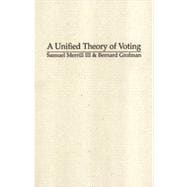
Unified Theory of Voting : Directional and Proximity Spatial Models
by Merrill, III, SamuelRent Textbook
Rent Digital
New Textbook
We're Sorry
Sold Out
Used Textbook
We're Sorry
Sold Out
Summary
Table of Contents
| List of Tables and Figures | p. ix |
| Acknowledgements | p. xiii |
| Introduction | p. 1 |
| Models of Voter Behavior | p. 17 |
| Alternative Models of Issue Voting | p. 19 |
| A Unified Model of Issue Voting: Proximity, Direction, and Intensity | p. 38 |
| Comparing the Empirical Fit of the Directional and Proximity Models for Voter Utility Functions | p. 52 |
| Empirical Model Fitting Using the Unified Model: Voter Utility | p. 67 |
| Empirical Fitting of Probabilistic Models of Voter Choice in Two-Party Electorates | p. 81 |
| Empirical Fitting of Probabilistic Models of Voter Choice in Multiparty Electorates | p. 91 |
| Models of Party or Candidate Behavior and Strategy | p. 107 |
| Equilibrium Strategies for Two-Candidate Directional Spatial Models | p. 109 |
| Long-Term Dynamics of Voter Choice and Party Strategy | p. 128 |
| Strategy and Equilibria in Multicandidate Elections | p. 144 |
| Strategy Under Alternative Multicandidate Voting Procedures | p. 158 |
| Postscript: Taking Stock of What's Been Done and What Still Needs to Be Done | p. 164 |
| Appendices | p. 170 |
| Glossary of Symbols | p. 195 |
| References | p. 196 |
| Index | p. 207 |
| Table of Contents provided by Publisher. All Rights Reserved. |
An electronic version of this book is available through VitalSource.
This book is viewable on PC, Mac, iPhone, iPad, iPod Touch, and most smartphones.
By purchasing, you will be able to view this book online, as well as download it, for the chosen number of days.
Digital License
You are licensing a digital product for a set duration. Durations are set forth in the product description, with "Lifetime" typically meaning five (5) years of online access and permanent download to a supported device. All licenses are non-transferable.
More details can be found here.
A downloadable version of this book is available through the eCampus Reader or compatible Adobe readers.
Applications are available on iOS, Android, PC, Mac, and Windows Mobile platforms.
Please view the compatibility matrix prior to purchase.
